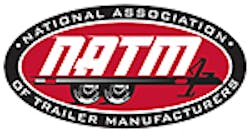THE Society of Automotive Engineers (SAE) Trailer Committee is tackling a couple of questions relating to SAE J2807, “Performance Requirements for Determining Tow-Vehicle Gross Combination Weight Rating and Trailer Weight Rating.”
J2807, first published in 2008 and then revised in September 2010, was expected to be adopted by truck manufacturers for the 2013 model year, but it wasn’t until recently that all of them agreed to adopt it for the 2015 model year.
The purpose of J2807 is to rate tow vehicles for maximum trailer weight to be towed, with a secondary purpose of evaluating trailer dynamic performance. It incorporates J684, J2638, J2664, and many other documents.
James Fait, chairman of the SAE Trailer Committee gave an update on the two topics being discussed:
• What tongue weight do we use when testing a trailer in this standard?
“The recent consensus of the committee has been 10% tongue weight for conventional trailers and 15% for fifth wheels and goosenecks,” he said. “We got some pushback on that because it seemed low in some instances, and it is. We understand it’s in the low or mid-range. But there are good reasons for that. First of all, in this document to set a reference trailer condition so you can compare tow vehicle to tow vehicle, you need to standardize everything. You don’t want to have three or four different conditions so the test becomes something that takes weeks to run. So we selected a reasonable mid-range tongue weight for that purpose.
“More vehicles will tow a higher trailer weight, if the tongue weight is kept to 15%. You will not need a dually, for instance. You do not need a higher tongue weight for dynamic handling. But when you go up to a 20% tongue weight, you overload the rear axle on the tow vehicle. The way the standard is written, that violates the criteria, so you can’t tow that trailer at that tongue weight. OEMs aren’t going to run out and change their F250 single rear axle pickup and up that rear axle capacity. They can’t just do that. It’s fixed hardware.
“So when they set the tongue weight at 15%, it actually allows you to tow that heavier trailer. At a 20% tongue weight, you need to look at the total tongue weight and how that weight impacts the tow vehicle. That really hasn’t changed. It’s the same tow vehicle now as was before. It has the same rear axle capacity. If a 20% tongue weight was going over a certain pickup before, it’s going to be the same situation. You will probably need that dually for that 24,000-pound trailer with a 20% tongue weight. But it allows the OEM manufacturer to set a standard at 15% tongue weight so you can allow that 24,000-pound trailer.
“Really, when you look at it as a trailer manufacturer, it is an advantage to you. You can choose to design your trailer at lower tongue weights, and it will fit more tow vehicles. The tow vehicles aren’t really going to change in that area.”
• Can tow vehicle rear GAWR be exceeded before weight distribution is applied, if weight distribution application brings the rear axle to GAWR or below?
“When we started to develop this standard in the mid-2000s, all the OEMs said, ‘No way, I don’t ever want my GAWR on my tow vehicle being exceeded,’ ” Fait said. “I think they had just never thought about it from the trailer industry side. To me, that’s really the purpose of weight distribution hitch system—to bring that axle load back under its GAWR.
“It’s being vetted right now for consensus. Should they be allowed to actually exceed GAWR when the tongue weight is applied, as long as it drops back under GAWR once they apply the weight-distribution system? I would think or hope that the trailer industry would support that position. I’ve talked to several people here in the trailer industry, talked to several people involved in the J2807 committee, and they all agree on that.
“It’s still going to be an OEM’s choice. It’s going to be his instructions. If an owner’s manual says you can’t do that, then you can’t do that. But it gives them the option of using that technique. I’d kind of like to see OEMs a little more open-minded than they were five or six years ago.”
He said the Trailer Committee is considering canceling J1214 (Tire to Body Clearance Check for Recreational Vehicles).
“We discussed it within the group and basically decided, ‘Nobody’s issuing it—it might not even be applicable to different suspension designs,’ ” he said. “So we sent that message out to RVIA (Recreation Vehicle Industry Association) and NATM and several entities and asked, ‘Is anybody even using this?’ So far, the response is, ‘Nobody is using it.’ So we’ll probably cancel that.”
Fait said the committee also is developing a 20,000-pound hitch rating to replace the hitch criteria in J684 (Trailer Couplings, Hitches, and Safety Chains—Automotive Type).
The committee is trying to raise a $175,000 budget for the cost of all road testing—to get several vehicles towing different size trailers with different GVWRs, ranging from 2000 pounds to 20,000, and running them on different surfaces to develop a duty cycle for a fatigue test.
“We’re revising the test criteria and approach phase where we’re hoping to have a test plan and funding from the industry,” he said.
Future documents being considered:
• Trailer Brake in Turn (BIT) Test Procedure. “That would fall under the Vehicle Dynamics Task Force. It’s something that’s been talked about off and on over years. We don’t have a clear test procedure on how to do that or what the performance requirements should be.”
• Trailer Folding Tongue Strength. “You have these collapsible tongues, and J684 doesn’t specifically say those tests loads apply to the trailer tongue. It really stops at the coupler and coupler attachment. I look at it and say, ‘That could or should apply to any trailer tongue.’ It’s something that has to be studied. We’ll try to bring a group together.”
• Trailer Tie Down Attachment Points and Strength. “For instance, on an open trailer, or perhaps even a closed trailer, you have different D-rings or anchor points. There are a lot of commercial industry standards very specific on strength and loading and how to tie down an object. We don’t have anything like that for a non-commercial trailer. We’d have to bring a group together and see if there is a need or want, or if this is even doable.” ♦
About the Author
Rick Weber
Associate Editor
Rick Weber has been an associate editor for Trailer/Body Builders since February 2000. A national award-winning sportswriter, he covered the Miami Dolphins for the Fort Myers News-Press following service with publications in California and Australia. He is a graduate of Penn State University.


